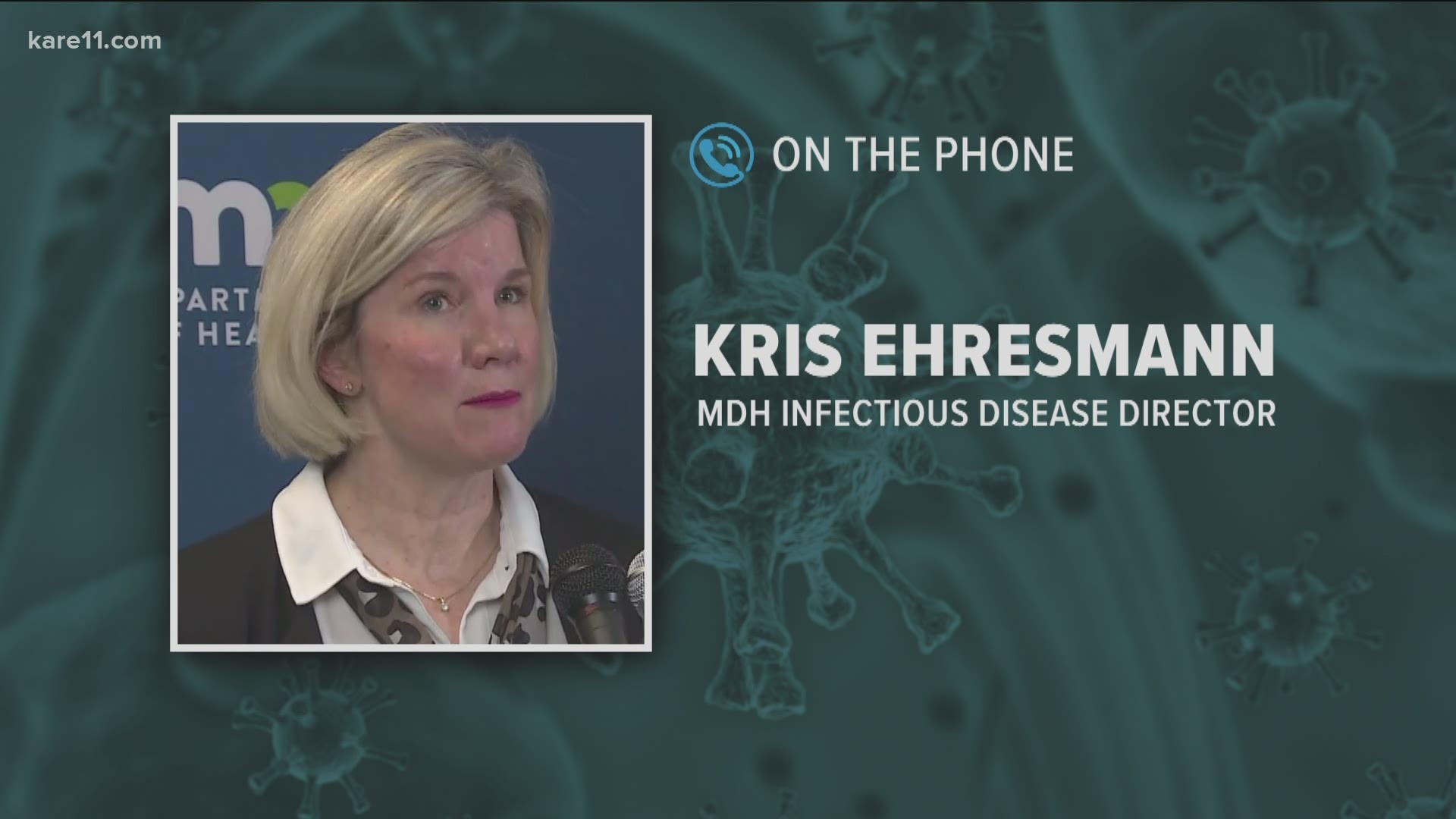ST PAUL, Minn. — Monday, Jan. 11
- Bars and restaurants open indoor dining at 50% capacity
- 5 cases of new COVID-19 strain confirmed in MN
- MDH technical issue leads to artificially lower case numbers
- Health officials report 'bump' in COVID cases after holidays
- Minnesota still on target to finish Phase 1a by end of January
2 p.m.
Minnesota health officials held a media briefing call to update the public on COVID-19 across the state, and the new variant originally identified in the UK.
Five cases of the variant, called B.1.1.7, were reported in Minnesota over the weekend.
Minnesota Department of Health (MDH) Commissioner Jan Malcolm said Monday's low number of four deaths reported is welcome, but does not necessarily indicate the numbers will continue to go down.
"That often is an artifact of weekend reporting from the mortuaries," Malcolm said. Unfortunately other lower days recently have not turned into a "trend," she said.
Malcolm said MDH is continuing to watch an uptick in test positivity and new COVID-19 cases.
MDH Public Health Lab Assistant Director Sara Vetter joined the call to talk about the new strain of COVID-19 now identified in Minnesota.
Five people from four different counties tested positive for the new variant, Vetter said. Four were identified through the MDH public lab, and one through a CDC collaboration. The counties were Hennepin, Dakota, Carver and Ramsey, MDH said, and two lived in the same household.
MDH Infectious Disease Director Kris Ehresmann warned that even though the new variant has only been identified in those counties so far, health officials are confident that it's spreading more widely than that.
"This is circulating in Minnesota," Ehresmann said.
The cases range from ages 15-37 and their illness onsets were all between Dec. 16 and Dec. 31. None were hospitalized. Two people reported international travel, one did not travel, and two had unknown travel history. MDH is continuing to investigate their exposure and their close contacts.
Vetter said officials don't yet know why the new variant may be impacting young people more.
"In general we see this virus affecting that age group more and so this variant kind of follows that pattern," she said.
"We expected that at some point we would find the virus in Minnesota," she added. "Knowing that it is now here does not change our public health recommendations."
Vetter said that while the new variant spreads more quickly, it does not appear to be more dangerous. Health officials also believe that the current COVID-19 vaccines will be effective against the new strain.
When asked whether vaccines will be needed annually, Ehresmann pointed out that experts do not yet know how long immunity lasts once someone has had COVID-19.
"It may be that it's necessary to receive an annual vaccination because of the duration of the protection," she said. But Ehresmann acknowledged that new variants could also prompt a need for regular vaccines, similarly to the flu shot.
"We are continually screening for new variants," Commissioner Malcolm said. "So we have been doing so all along and we will continue to do so."
Malcolm said that MDH expects that the new, faster-spreading variant, combined with the increased indoor time this winter, will cause an increase in COVID-19 cases in Minnesota.
According to the CDC, 63 cases of the new variant have been identified in eight states, Vetter said.
Regarding Minnesota's progress getting vaccines administered, Malcolm acknowledged that not every aspect is under MDH control.
"Are we satisfied?" she said. "No. We would like to speed up every step of that process that we can."
Malcolm said health officials "hope and intend" to improve in state-to-state comparisons of vaccine progress, even though she contended those comparisons are not always "apples to apples."
11 a.m.
The latest COVID-19 data reported Monday by the Minnesota Department of Health (MDH) shows the lowest case numbers, deaths and testing volumes in recent memory, partially due to a technical glitch.
MDH says 980 cases of coronavirus were recorded in the past day, based on results from 15,980 cases (14,993 PCR, 987 antigen) processed in private and state labs. Health officials consider a positive PCR test a confirmed COVID case, while a positive antigen test is considered a probable case.
The state has reported a total of 437,552 positive tests (16,836 from antigen tests) since the pandemic began.
Four more Minnesotans have died from COVID-19, bringing total fatalities to 5,711. It is the first single-digit death total since Nov. 2, when 9 people perished from the virus.

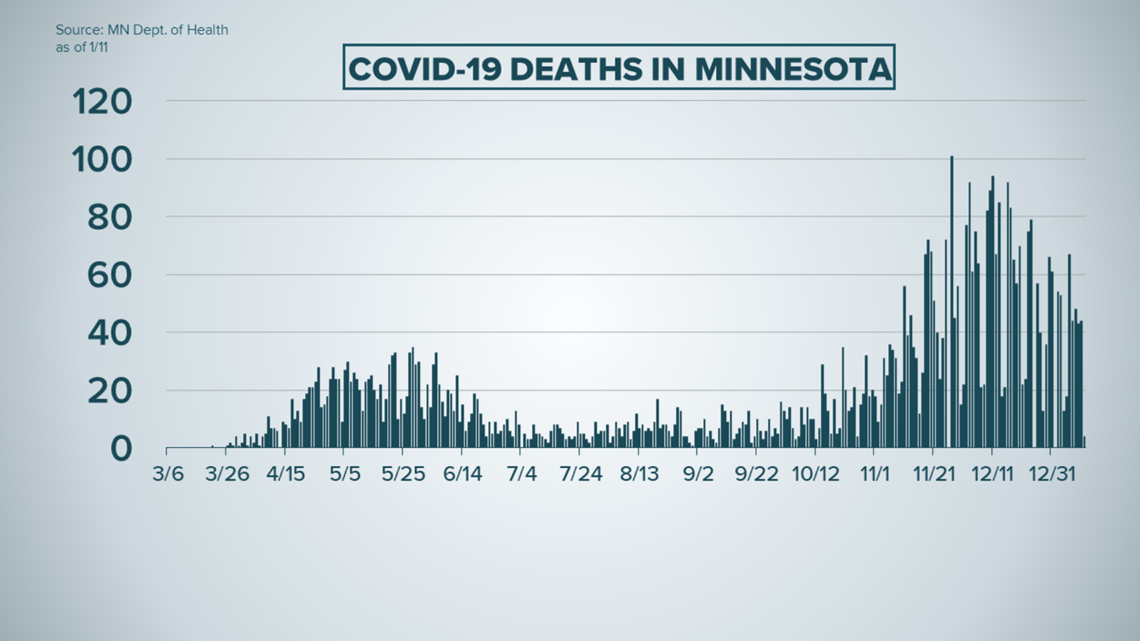
MDH spokesman Doug Schultz explains that a delay in loading a file with tests from Sunday resulted in those results not making it into Monday's report, creating numbers that are artificially low. Schultz says there were 558 positive test results from the file that will be included in Tuesday's report, making tomorrow's case numbers artificially high.


Schultz adds that it's important to know that "the 558 positive tests in that file represent both new COVID cases and repeat tests on known cases, so the number of new cases represented by that file (to be reported Tuesday) will ultimately be less than 558."
Vaccinations given to vulnerable groups, front line workers and first responders now sit at 147,645.
The number of patients hospitalized statewide with COVID-19 continues on a steady decline. As of Sunday 686 beds were being used to treat coronavirus patients, with 141 of them in the ICU. Availability of beds in Twin Cities metro hospitals is steady, with 3.9% of non-ICU beds open (142), and ICU beds have an availability rate of 9.4% (65).

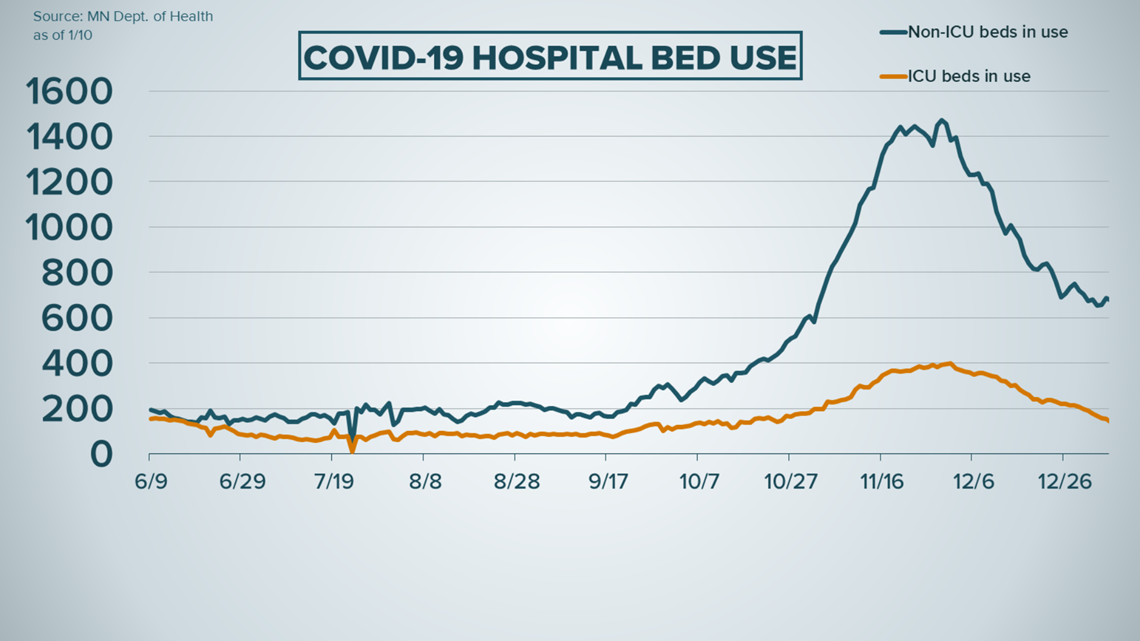
Total hospitalizations for COVID-19 now sit at 22,815, with 4,783 of those patients needing ICU care.
MDH says 417,005 people who at one time tested positive for the virus have recovered to the point they no longer require isolation.
Young adults continue to make up the largest grouping of COVID cases: Those 20 to 24 account for 44,195 cases and three deaths, while 25 to 29-year-olds number 39,474 cases and six deaths. People 85 to 89 comprise the largest group of fatalities from the virus with 1,075 in 5,774 diagnosed cases.
Hennepin County has recorded the most COVID activity in the state with 91,060 cases and 1,447 deaths, followed by Ramsey County with 39,054 cases and 722 deaths, Dakota County with 32,250 cases and 309 deaths, and Anoka County with 30,430 cases and 347 fatalities.
Cook County has the least COVID activity with 111 cases and zero deaths.
Sunday, Jan. 10
2 p.m.
Wisconsin's Department of Health Services (WDHS) reported 1,832 new cases Sunday, bringing the total number of cases since the pandemic began to 506,890.
Health officials reported two new deaths on Sunday as the total number of fatalities rose to 5,157.
Wisconsin health officials say a total of 22,378 people have been hospitalized from the coronavirus since the start of the pandemic, about 4.4% of the total number of people who have been diagnosed with the virus.

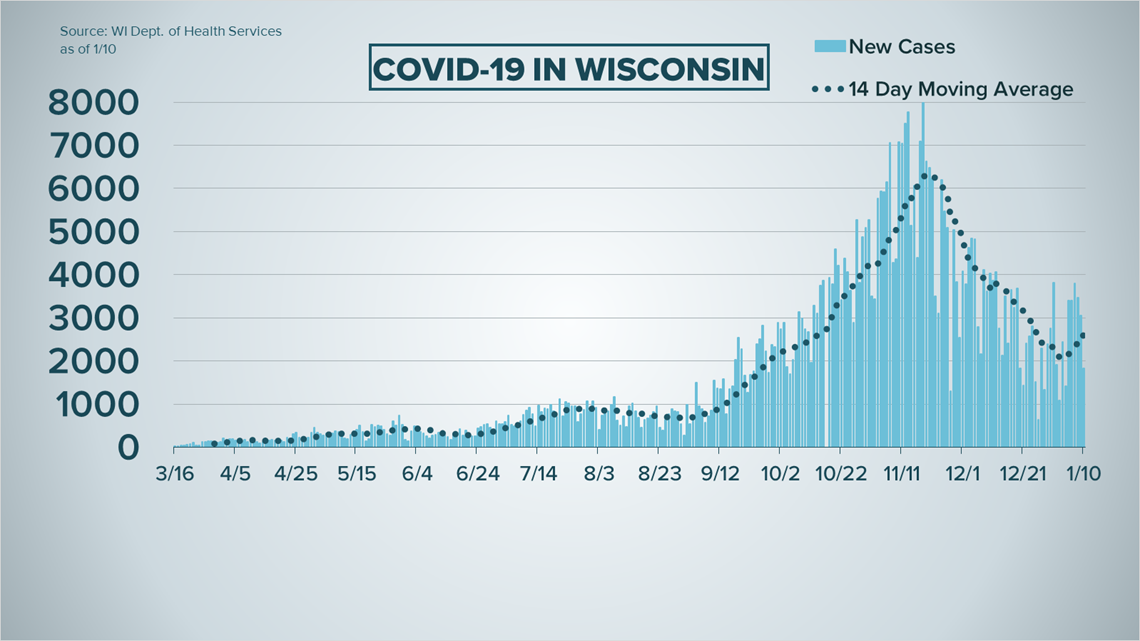
Of the confirmed cases in Wisconsin, 19% involve people between the ages of 20 to 29, 16% are between 30 and 39, 15% are between 50 and 59, and 14% are 40 to 49. An estimated 11% are between 10 and 19, and another 11% are between 60 and 69.
As of Sunday, Milwaukee County reported the largest number of confirmed cases with 88,939, along with 995 deaths. Waukesha County has reported 36,362 confirmed cases and 373 deaths, Dane County has reported 35,391 confirmed cases and 211 deaths, and Brown County has reported 27,535 cases and 168 deaths.
11 a.m.
COVID-19 deaths have remained fairly steady over the past few days, while vaccination numbers rise.
The Minnesota Department of Health reported 2,165 new COVID-19 cases and 44 deaths Sunday.
Sunday's deaths bring Minnesota's total to 5,707 since the pandemic started. Of those deaths 3,653, or 64% of them, are linked to people in long-term care or assisted living settings.
The 2,165 newly reported cases bring Minnesota's total to 436,572. Sunday's new cases are based on results from 40,189 tests (34,515 PCR and 5,674 antigen). Health officials consider a positive PCR test a confirmed COVID case, while a positive antigen test is considered a probable case.

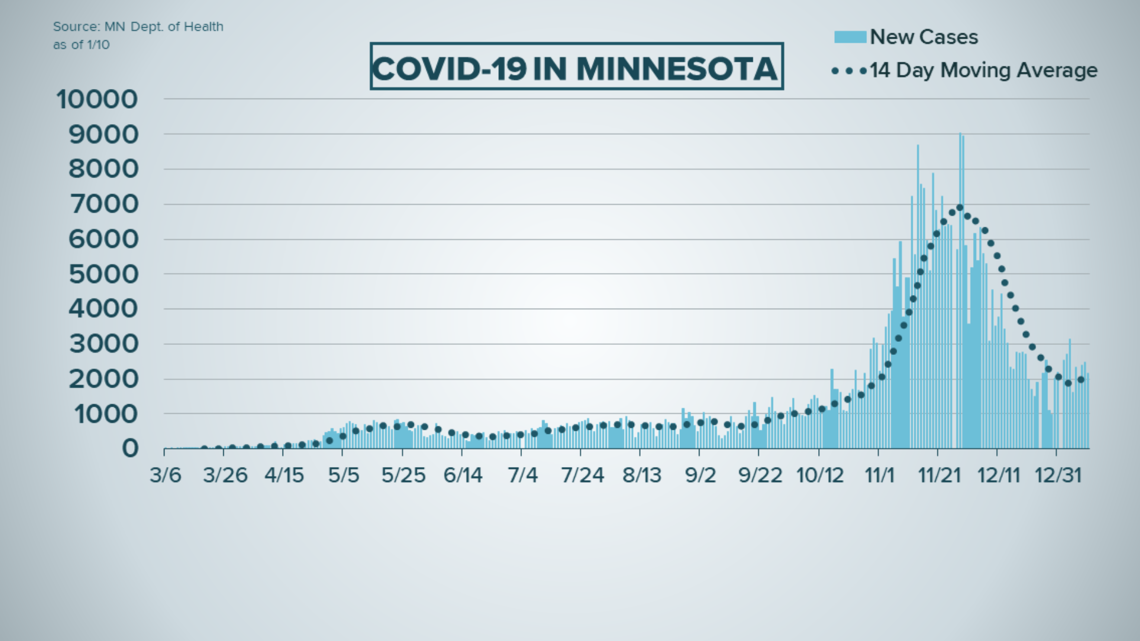
MDH updates its hospital capacity data on weekdays. As of Thursday, 759 COVID-19 patients occupied hospital beds across the state, with 130 of them being treated in ICU beds. Occupancy rates in hospitals across the Twin Cities metro appear steady, with just 3.6% (133) of non-ICU beds open, and 7.1% (49) of ICU beds available. In total, 22,763 people have been hospitalized in Minnesota since the onset of the pandemic, with 4,770 in ICU.
At this point, 414,756 people who have tested positive for the virus have recovered sufficiently to not require isolation.
Minnesota has also passed a notable milestone with more than 100,000 doses of vaccine administered. As of Sunday, 132,280 people have been vaccinated, and MDH officials say those numbers are ramping up.
Young adults still account for the most coronavirus cases in the state, with those 20 to 24 making up 44,112 cases and three deaths, while 25 to 29-year-olds are linked to 39,393 cases and six fatalities. The largest grouping of deaths involves people 85 to 89, with 1,075 fatalities in just 5,757 diagnosed cases.
Hennepin County has recorded the most COVID activity of any county in the state with 90,839 cases and 1,447 deaths, followed by Ramsey County with
38,963 cases and 722 deaths, Dakota County with 32,154 cases and 308 deaths, and Anoka County with 30,354 cases and 347 deaths.
Cook County in northeastern Minnesota continues to have the least activity with 111 cases.
KARE 11’s coverage of the coronavirus is rooted in Facts, not Fear. Visit kare11.com/coronavirus for comprehensive coverage. Have a question? Text it to us at 763-797-7215. And get the latest coronavirus updates sent right to your inbox every morning. Subscribe to the KARE 11 Sunrise newsletter here. Help local families in need: www.kare11.com/give11.
The state of Minnesota has set up a data portal online at mn.gov/covid19.

